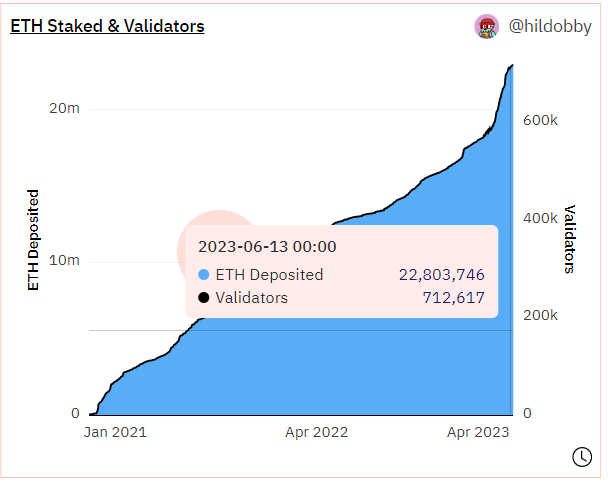
Validator staking amount increase proposal
At the Ethereum (ETH) Blockchain Core Developers Conference on June 15, a new proposal was discussed to increase the maximum staking amount that ETH validators can hold.
The proposal claims that increasing the amount of ETH that a single node can stake will reduce the total number of validators, resulting in various benefits for the entire Ethereum network. .
Under the current system, Ethereum validators are required to hold 32 ETH (about 8 million yen) uniformly. However, Michael Noider, a researcher at the Ethereum Foundation who created the proposal, said that the minimum holding requirement of 32 ETH will remain the same, but the maximum amount that one validator can stake will be raised to 2,048 ETH (about 500 million yen). is proposing.
According to DUNE data, there are 700,000 active validator nodes at the time of writing, with an additional 90,000 new validators on the waiting list. The Ethereum network limits the number of validators that can be added over a period of time.

Source: DUNE
Noider points out that while the current 32 ETH holding requirement helps decentralize the Ethereum network, it may undermine the efficiency of the network as a whole. He argues that limiting the number of validators by increasing the amount of staking will yield the following benefits:
- Reduced load of direct communication between nodes (P2P layer)
- Improving the efficiency of staking ETH withdrawal processing
- Improving block processing speed and achieving “single-slot finality”
- Efficient block generation and realization of “Proposer-Builder Separation (ePBS): Role separation between block proposer and block builder”
Noider also claims that it will improve the complex infrastructure management issues faced by large staking providers. Behind the scenes is the current situation where major exchanges like US Coinbase operate tens of thousands of validators.

Source: DUNE
However, Mr. Noider said that there is a risk of blockchain forking due to “double attestation,” in which two or more block approvals occur by chance for the same block, and that penalties for nodes that commit fraud, “thrashing (staking tokens).” There are also risks that should be carefully considered when implementing this proposal, such as the possibility of strengthening the confiscation of
What is staking
Staking is a mechanism in which rewards are obtained by depositing a certain amount of virtual currency for a predetermined period of time. Staking can be done in currencies that adopt the PoS (Proof of Stake) consensus algorithm.
 Cryptocurrency Glossary
Cryptocurrency Glossary
connection:Vitalik’s Proposal: The ‘Three Transitions’ Essential for Ethereum’s Evolution
Automatic compounding of redator rewards
Besides increasing the maximum staking ETH that a validator can have, Noider also proposed automatic compounding of validator rewards.
The automatic compounding of rewards is said to improve the profitability of ETH held by validators. Currently, in order to re-stake the staking reward, it is necessary to withdraw the reward once and install a new validator. However, if the staking limit is increased, the rewards will soon be compounded.
The proposal will continue to be discussed among the major developers. Further discussion of implementation details will take place on the ETH forum and social platforms such as Discord.
connection:Ethereum’s next upgrade “Dencun”, what is the importance and merit?
What is a validator
Approver means a node that verifies the validity of data recorded on the blockchain. It has a role such as verifying transaction history, and if you fulfill that role, you will be rewarded with virtual currency.
 Cryptocurrency Glossary
Cryptocurrency Glossary
The post From 32 ETH to 2,048 ETH Ethereum Improvement Proposal, Aiming to Improve Network Efficiency by Increasing Maximum Staking Volume appeared first on Our Bitcoin News.

 1 year ago
90
1 year ago
90














 English (US) ·
English (US) ·